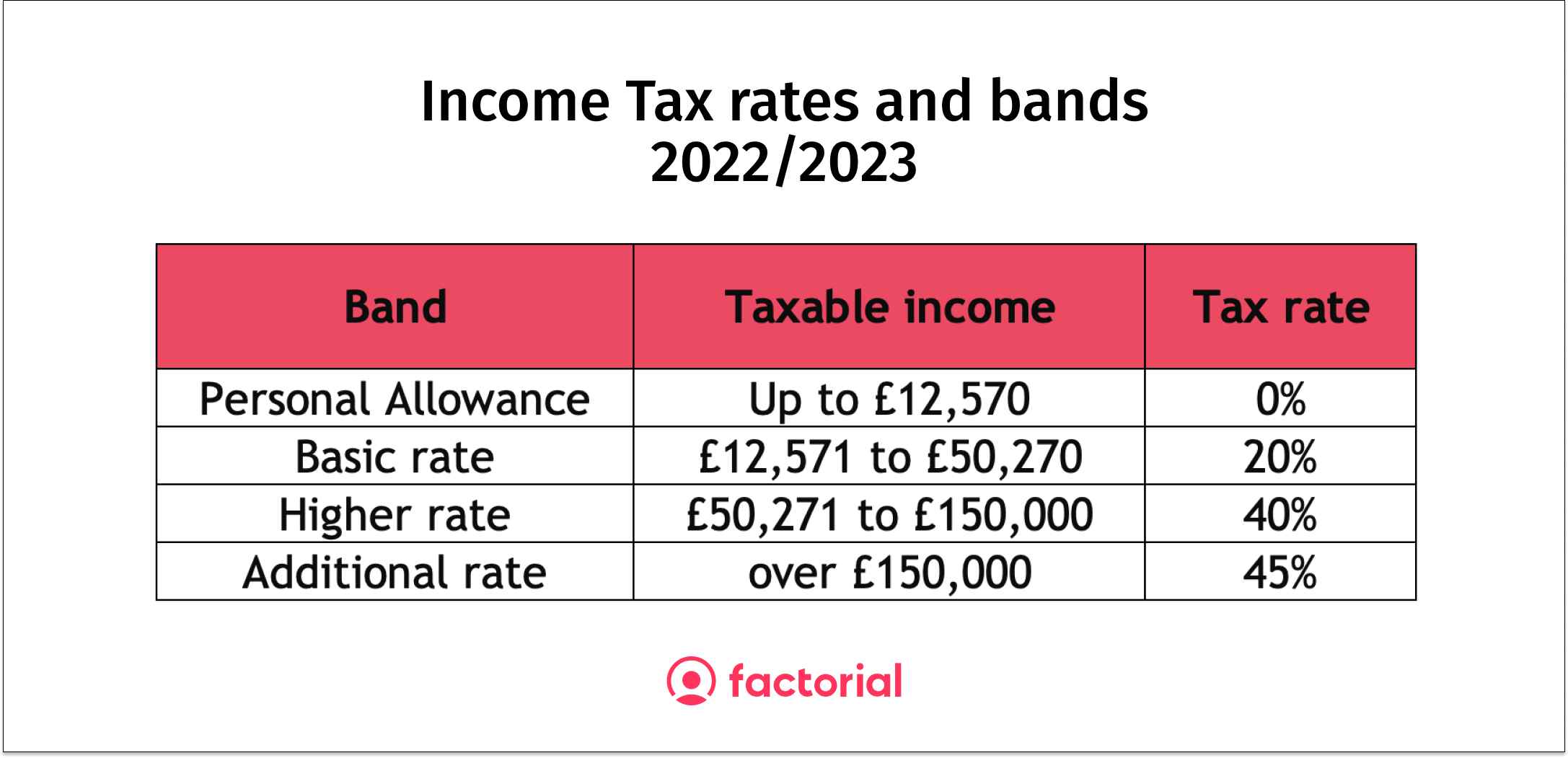In the UK, each employee is given a HMRC tax code from a long list of tax codes. Each one represents how much money is deducted from your salary and collected through P.A.Y.E. every year. These jumbles of numbers and letters can be confusing, but understanding them is crucial to understanding how much income tax you are paying. Our handy list of tax codes and what they mean below is the perfect place to start.
This guide will also explain tax codes more generally and answer the most common questions surrounding them, including: What is a tax code? What tax code should I be on? Why has my tax code changed? Why is it wrong and how do I update it?
- Tax Codes Explained
- What is my Tax Code?
- What is Tax Code BR?
- List of Tax Codes and What They Mean
- Why has my Tax Code Changed?
- What do I do if my Tax Code is Wrong?
- When do I Need to Update my Tax Code?
- ✅ Automate and Centralise your Payroll Processes with Factorial
Tax Codes Explained
So, what is a tax code?
A tax code is an alpha-numeric code that is applied by HMRC to every employee in the UK. It usually consists of 3-4 numbers and 1 letter. Your employer uses this code to figure out how much income tax they should deduct from your pay. Tax codes can also be used by pension providers to work out how much tax to deduct from your pension.
HMRC, the UK’s tax office, expects each individual to check their tax code and correct it if necessary. For this reason, it’s important you know your stuff to avoid receiving an unexpected (and probably unwelcome) tax bill.
It’s easier to understand the code by breaking it down.
Your code begins with a number. This represents your personal allowance entitlement for the current tax year, i.e. your tax-free income. This is calculated by HMRC, taking into account your personal allowance and any income that hasn’t been subject to tax. Earnings from a part-time job are an example of this. Any benefits you receive as part of your job are also incorporated into these calculations, such as a company laptop.
The letters are a bit more complex. They represent your circumstances and the impact this has on your personal allowance. The full list of letters is pretty lengthy, but we’ve recorded and explained the most common ones below.
What is my Tax Code?
So now you understand the basics, but you may still be wondering: what is my tax code?
You’ll need to check your own income tax code to know how much tax you will have to pay. Spoiler alert: it will most likely be 1257L. This is the most commonly occurring tax code for 2022/23.
However, it’s safest to check your tax code before assuming it. There are 3 main ways to do so:
- Check your payslip
- Refer to the HMRC app
- Check a ‘Tax Code Notice’ letter (these are from HMRC – you won’t have necessarily received one of these)
If you’ve registered online and have a personal tax account, you can head there to check your income tax code from last year.
For workers that have a second job, it’s best to ensure your highest-paying job has a tax code ending in ‘L’ rather than ‘BR’. This is because you don’t have a personal allowance for your second job. More on this below.
What is Tax Code BR?
The tax code ‘BR’ is specifically for employees working a second job. It stands for ‘Basic Rate’ and means that your income on this job will be taxed within this band, which is currently 20%. It can also be applied to a second pension.
HMRC counts one job as your main job. This is the one that they apply a tax-free allowance to. However, the income from a second job is added onto the total earnings from your first and therefore doesn’t qualify for a personal allowance. It’s not as harsh as it sounds – the income tax works out the same as if this income all came from one job.
If your second job means that you earn enough to be pushed into the higher tax brackets, your tax code will either end in D0 for the higher rate or D1 for the additional rate.

List of Tax Codes and What They Mean
Here are a few of the most common income tax codes and what they actually represent.
- L: Under 65s receiving the basic personal allowance. This is the most common for tax-paying workers.
- BR, D0 and D1: As mentioned, this is for second jobs and pensions.
- M and N: Marriage Allowance. N means you’ve transferred 10% of your personal allowance onto your spouse, and M means you’re the receiver of this. This is only possible if your total earnings are below £12,570 per year and your spouse doesn’t fall into one of the higher tax brackets.
- K: You don’t get a personal allowance. Some examples of when this might occur include:
- Back-paying tax from a past year.
- You have received a company benefit worth more than your personal allowance (e.g. a car).
- You receive taxable benefits (either from your company or the state).
- Y: Aged 75 and over receiving the maximum possible personal allowance.
- S: Scottish Income Tax. This will be at the beginning of your HMRC tax code if Scottish income tax rates are applied to your earnings.
- NT: You don’t pay any tax, usually because your income has not reached a taxable amount or you’re a self-employed contractor paying National Insurance but no income tax.
- T and 0T: For workers earning £100,000 and above per year. Every £2 you earn will cost your personal allowance £1. The letter ‘T’ in your HMRC tax code should have a number before it, this being the amount of remaining personal allowance after these deductions. Once your earnings reach £125,140 your tax code will change to 0T, meaning your personal allowance no longer exists and all of your income will be taxed.
- W1, M1 and X: Emergency tax codes. Tax will be deducted from earnings above your tax-free allowance. This might happen if your situation or job has changed but HMRC didn’t get your new income information in time. These are temporary and will only be applied until yourself or, usually, your employer provides updated details.
Can’t find your tax code here? For the full list of tax codes and what they mean, refer to the government website.
What Are Emergency Tax Codes?
An emergency tax code is a temporary tax code that the HMRC gives employees when they don’t have enough information about their income to know which tax code they should be given.
Emergency tax codes are used when:
- Someone starts a new job.
- Returns to work after a break or changes from being self-employed to employed.
- Starts receiving new company benefits without the relevant information being supplied to HMRC.
Why Are Emergency Tax Codes Used?
The idea behind an emergency tax code is that employees can still pay taxes even if HMRC is unclear about which tax code they should use in the long term. Employees avoid being hit by a larger tax bill later by paying taxes from the start of employment.
What Are The Emergency Tax Codes?
If your tax code ends in ‘W1’, ‘ M1’ or ‘X’, you’re on an emergency tax code. W refers to weekly pay, M refers to monthly income, and X is used when your pay varies.
Some examples of emergency tax codes in the UK include:
1257L W1/M1
This is the standard tax-free allowance calculated weekly/monthly without reference to previous earnings in the tax year.
0T
No personal allowance is applied.
BR
All income is taxed at the basic rate of tax. This code is usually used for second jobs.
How to Resolve an Emergency Tax Code
You can resolve an emergency tax code by ensuring that HMRC receives information about your new employment status. For example, you can:
- Provide a recent P45 from your previous employer to your new employer.
- Ensure you and your employer have completed a Starter Checklist (previously called P46).
- Check your tax code includes your state or private pension, if applicable.
- Contact HMRC directly.
Once HMRC receives the correct information, an updated tax code will be issued to the employer, and the next pay cheque will reflect the correct tax code. Any overpaid tax is usually refunded through payroll. If you have underpaid for the amount of tax you owe, HMRC will keep you on the temporary code until you have paid the right amount.
The process of updating the tax code can take up to 35 days.
Why has my Tax Code Changed?
At the start of every tax year, HMRC will issue a new tax code to each worker. You won’t be contacted if you have a standard tax code that remains the same. However, if your income tax code has changed, yourself or your employer will be sent a P2 form (by post or email) detailing the change and how they worked it out.

What do I do if my Tax Code is Wrong?
A tax code could be incorrect for a few reasons, such as:
- Your circumstances or job changed and you or your employer didn’t supply the new details to HMRC in time, so you’re on an emergency tax code.
- Your company benefit was taken away.
- You’ve not claimed tax relief for expenses that you should have had allowances for.
Put simply: if you’ve overpaid tax you may be due a tax rebate, if you’ve underpaid tax you may owe HMRC money. In either of these situations, HMRC will send you a tax calculation letter (known as a ‘P800’) or a Simple Assessment letter.
You should notify HMRC as soon as you’ve noticed that your tax code is incorrect. Contact them directly using the details listed here.
When do I Need to Update my Tax Code?
Significant changes to your circumstances will mean you need to update your code. Usually, your employer will make the change for you by sharing your details with HMRC. The most notable occasions you should update your income tax code are when:
- You’ve begun a new job. (Your P45 should tell your new employer everything they need to know)
- You’ve previously been self-employed but now work for a company. (A ‘new starter checklist’, also know as a P46, should cover the necessary information)
- You’ve begun receiving benefits or a State Pension. (Reference the list of tax codes above and check that your tax code matches the benefits/pension code).
Automate and Centralise your Payroll Processes with Factorial
Managing tax codes, P.A.Y.E. and payroll is often manual and time-consuming, but it doesn’t need to be. You can automate and centralise your processes with Factorial’s payroll management software.
Our digital solution allows you to:
- Centralise all payroll documents in one place.
- Approve or reject expense requests at a glance.
- Automatically create payslips rather than building them one-by-one.
- Automatically add expenses as additional supplements in payroll.
- Allow managers to gather supplements for you.
- Schedule periodic compensations and supplements per employee.
- Manage and share anything relating to payroll.
- Gain insights with payroll reports and analytics.
- Access our network of certified bookkeepers to help you along the way.
If you want to start streamlining your processes for payroll, recruitment, onboarding, time tracking and more, try our all-in-one HR software free for 14 days with a trial.


